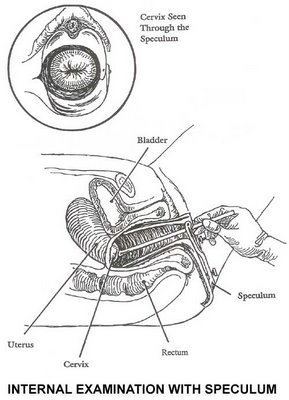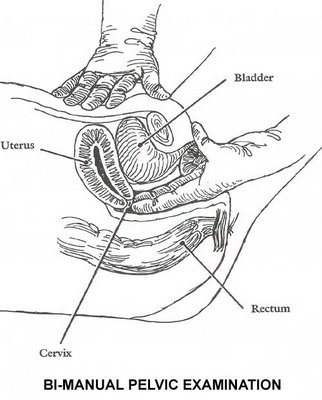What to expect at your first pelvic exam


I no most girls who read this blog have already done it, but here it goes I've found this in a blog (which has pop-ups, so I took the liberty to post a transcript of it) and as there must be still millions of girls you are wondering how it is. For the guys who read this you now can see what we must undergo for much more years then you!
"Not sure what to expect at your first pelvic exam? Are you afraid? Embarrassed? Well, don't be! It's all part of being a woman, and the sooner you get used to the idea of having gynecological exams, the better, because these will be part of your life forever. I hope the following information will be useful and will help you relax as you face your first visit to the gynecologist.
There are no hard and fast rules about when a girl should start seeing a gynecologist, but these are some guidelines:
- You are sexually active, or are planning to become sexually active.
- You're older than 15 or so but still haven't started menstruating.
- You're experiencing lower abdominal pain, excessive bleeding, irregular periods, or unusual discharge.
- You think you might be pregnant.
- You're concerned that you may have been exposed to a sexually transmitted disease.
- You want to get on birth control.
- You've found a lump in your breast
When you're ready, you're going to have to choose a gynecologist. If your mother, sister, friend, etc., has a gynecologist that she trusts and likes, you might consider seeing the same doctor. If you're new in town and don't really know anyone to ask for personal recommendations, you can call local hospitals, Planned Parenthood clinics, the health center at your college, etc., and ask for recommendations.
A lot of women are very uncomfortable with the idea of having a male physician examining their genitalia; you may be more at ease with the idea of seeing a female physician. Keep in mind that the doctor's gender shouldn't make any difference, as they've had the same training and are obligated to observe the same rules when seeing patients, but if you simply can't fathom the idea of being examined so personally by a male, choose a female. You should also keep in mind that during the exam, regardless of whether you're seeing a male or female physician, you have the right to request that a female (nurse, friend, parent, etc.) be present.
Once you've chosen the doctor and made your appointment, you'll need to prepare for the visit. Basically, there are just a few things you shouldn't do: Don't have sex, or douche, or use any type of vaginal products for at least 24 hours prior to your exam. (You really should never douche, but that's a whole different topic!)
When you arrive at the doctor's office, you'll be presented with forms to fill out; these will ask for your personal and family health histories, and may ask what brings you there (i.e., are you having a specific problem?), whether you're sexually active, etc. A nurse will call you in and will take your vital signs (weight, height, blood pressure, pulse, temperature), and may ask you for a urine specimen. (Even if they don't ask for a urine specimen, be sure you empty your bladder prior to the pelvic exam. This will definitely make it more comfortable!)
S/he will probably ask you some basic questions about your health and why you're there. At this point s/he may take you to a consultation room or office, or she may leave you in the exam room. If s/he instructs you to remove your clothes and put a gown on, but you'd prefer to meet your doctor while you're fully clothed, let her/him know. (You can ask about their procedure for new patients when you call in to make your appointment. If they're unwilling to respect your choice to see the doctor for the first time while you're wearing your clothes, find another doctor.)
Finally, the doctor will join you. Be prepared for some general chit-chat and basic "getting to know each other" conversation. If you have any questions or concerns, this is a good time to bring them up. Once you're being examined it's easy to forget things you wanted to say. It's a good idea to bring a written list of things you want to ask, so that even if nerves take over you'll still recall everything you wanted to say.
Your doctor will leave the room (if you're already in an exam room) or will escort you to an exam room, and will give you a gown to put on and a sheet to cover up with. While you're waiting for her/him to return, try to relax by doing some slow, deep breathing.
Once the exam begins you should be thoroughly checked from head to toe, even though this is a gynecological visit. The doctor should check your eyes, ears, nose, and throat, then move down to feeling the glands in your neck, listening to your heart and lungs, and checking your reflexes. S/he may take your blood pressure again, as well.
The breast exam will come next. If you're not currently performing breast self-exams, let your doctor know so that s/he can teach you the correct way to do it, as well as the best time of the month.Last, but definitely not least, comes the pelvic exam. You'll be asked to slide your bottom all the way to the end of the exam table; this can feel quite disorienting if it's your first time, because you'll swear you're going to fall off. But you won't! Your feet will be placed in stirrups (some exam tables have leg holders instead of stirrups) and you can help by letting your legs fall open. Don't tense up or try to keep your legs together; just let them fall naturally apart. This is probably when you're going to feel most embarrassed and vulnerable, but just remember that the doctor has done this hundreds, if not thousands, of times and while it's new to you, it's not new to them. For them, it's just part of a day's work.
The exam will begin with the doctor visually examining your external genitalia; they're looking for abnormalities such as cysts and they're also noting the size and condition of your clitoris and your labia minora and majora. The doctor must separate the labia in order to see the vaginal introitus (opening) and the urethral opening.
Your doctor may proceed by inserting a finger into your vagina in order to determine the speculum size best suited to you, and also to check to see if your hymen is intact. Or they may proceed by inserting the speculum. Either way, it's very important that you keep your abdominal and pelvic muscles relaxed now, as tensing them up will make the exam difficult for the doctor and uncomfortable or painful for you. Once again, taking slow, deep breaths can help you relax.
If at any point during the internal exam you're experiencing pain or discomfort, let the doctor know. But keep in mind that since this is a new experience for you, it's possible that it simply feels odd and unusual, but isn't actually painful. The speculum is inserted while it's closed; only after it's correctly positioned inside your vagina will its blades be opened; this should not hurt. The doctor will direct a very bright lamp at your vagina so that s/he can see what's going on in there; this may feel warm, but don't let it startle you. They're looking for a number of things, including the size, condition, and placement of the cervix (the opening of the uterus), any lesions/sores/cysts on the vaginal walls, and any discharge or bleeding. The last step of the speculum exam is the Pap test (teste Papanicolau), in which the doctor will take scrapings from the cervix and the vagina. Again, this may feel strange, but it should not be painful. Above is a diagram of a speculum exam.
Once the speculum has been withdrawn, the doctor will move on to the manual portion of the exam, in which they'll insert gloved, lubricated fingers into your vagina. Depending on various factors the doctor may insert a single finger or two fingers. While their fingers are in the vagina, they'll use their other hand to press on your abdomen in order to feel your internal organs, including the ovaries and uterus. This may be a little uncomfortable but shouldn't hurt. Above is also a diagram of a bimanual exam.
Finally should come the rectal and/or rectovaginal exam. In the former, the doctor places one finger in the rectum, while in the latter they insert their index finger into the vagina and their middle finger into the rectum. This is a very important part of the pelvic exam as it allows the doctor to check the rectum for abnormalities such as hemorrhoids, fissures, and signs of cancer, allows them to have a better feel of certain organs, and is the best way for them to check the wall between the vagina and rectum. No pelvic exam is complete without a rectal exam, so if your doctor doesn't automatically include it be sure to request it.
You'll now have another opportunity to discuss things with the doctor before they leave the room. If you're going on birth control be sure to discuss all of the options available to you, including when you should come back for a followup visit. If there's anything you forgot to ask, you can do it now.
Most Pap smears are normal, and chances are you'll receive a lab report in the mail informing you that yours was, too. In the event that any abnormalities were found, or if the results were inconclusive, you'll hear from the doctor's office and be asked to come in to be retested. Don't let this alarm you as there are many reasons a Pap test may initially appear abnormal, yet everything turns out fine when you're retested. Of course if something abnormal really is found, you and your doctor will discuss a plan of action.
Well, that's it! You've made it through your first visit to the gynecologist and you're well on your way to taking charge of your own healthcare and well being.
(NOTE: No two doctors perform exams in exactly the same manner, so your exam may proceed differently from what I've described. However, even if things are done in a different order, all of what I've described should be done during the course of the exam. If your doctor skips anything, don't feel strange about asking them to do it. Believe me, they will not think you're weird for asking!)"
2 comments:
A pelvic exam is rape.
"Discomfort/pain, shame/embarrassment, and/or a feeling of being violated, as a result of penetration of the sexual organs by a person in whom a woman has no sexual interest, achieved through coercion, fear, and/or intimidation."
http://agalltyr.wordpress.com/2010/11/28/a-pelvic-exam-is-rape/
One should not wait for such symptoms to show before going to a gynecologist's office. It's important to have regular check-ups to be aware of your condition. Such exams are done in order to successfully give patients reliable answers to their concerns, so there shouldn't be any worries for women at all. Gynecologists are professionals and are very educated.
Post a Comment